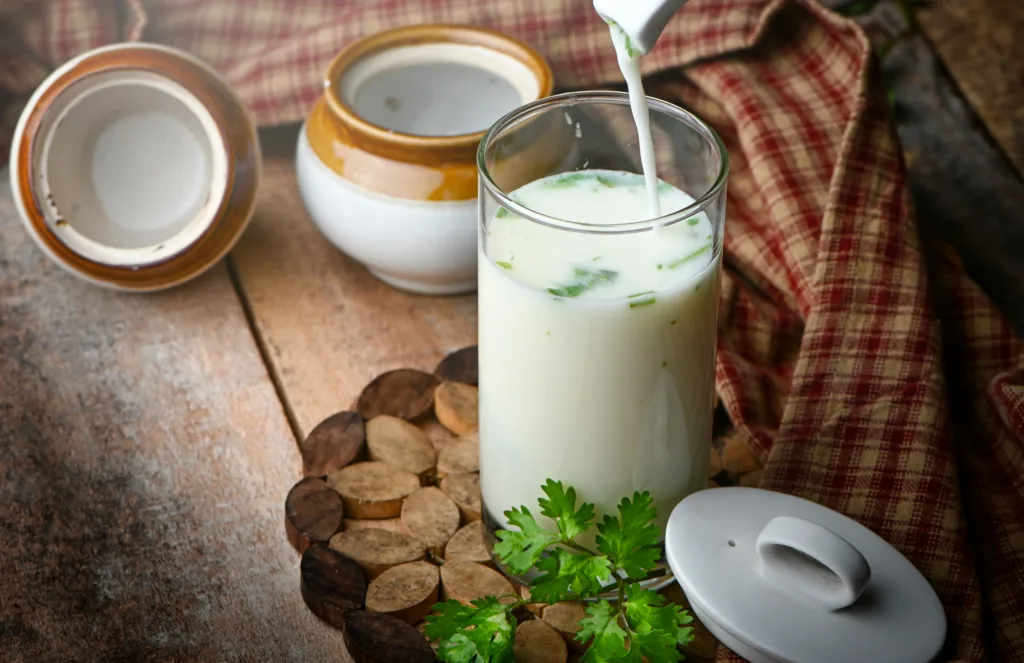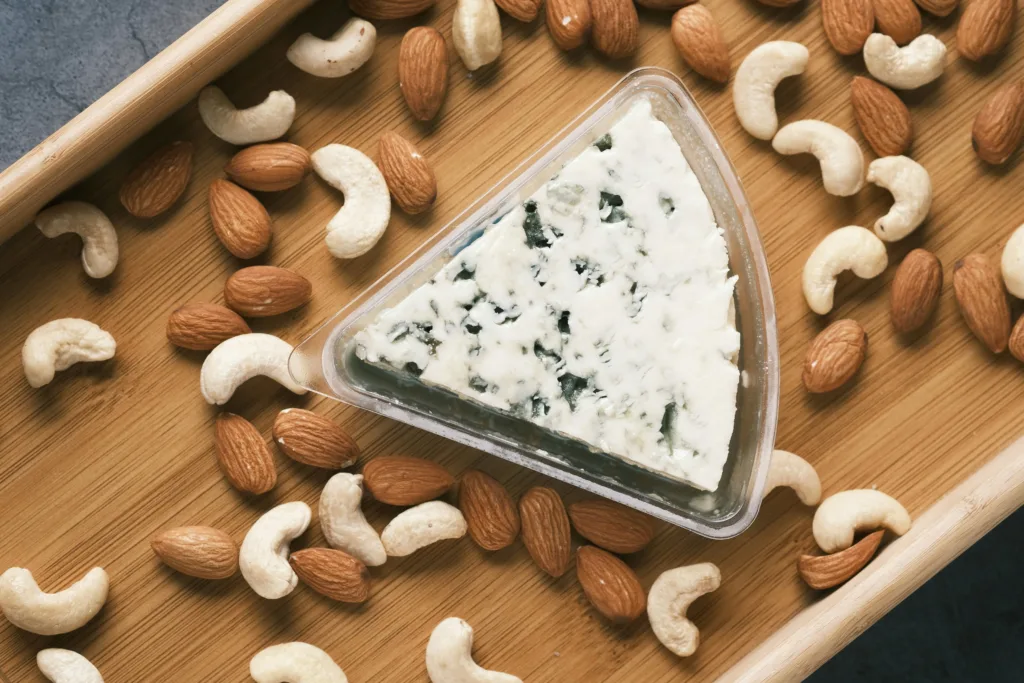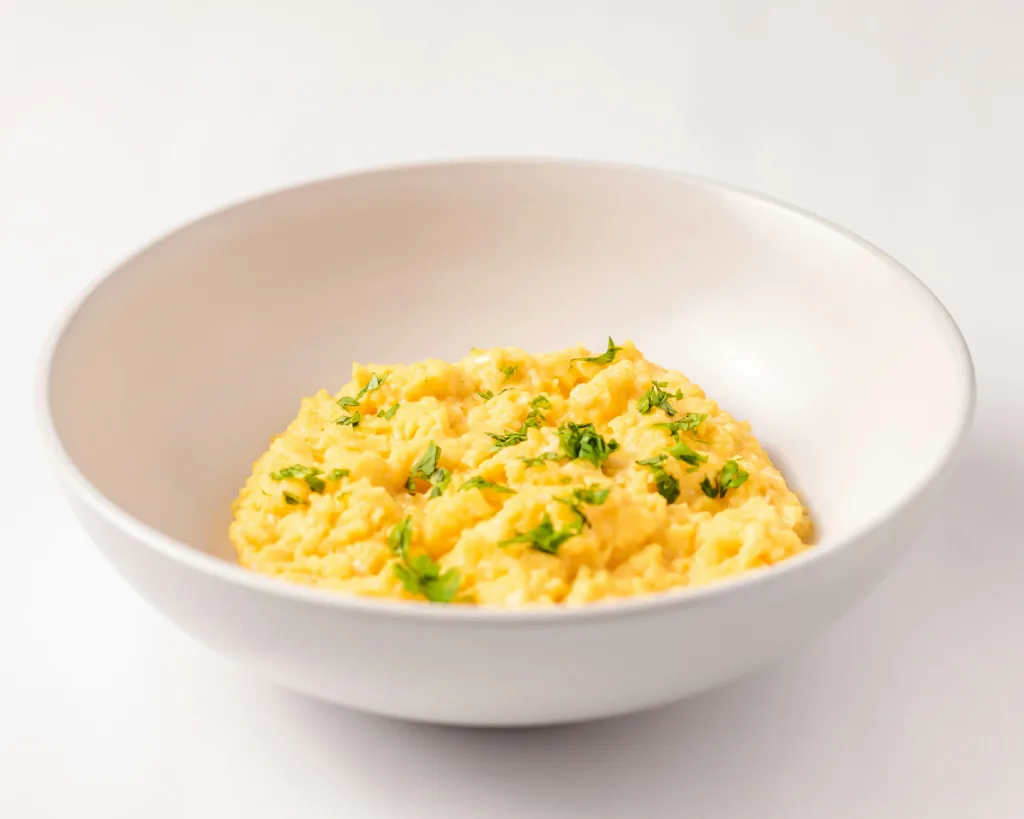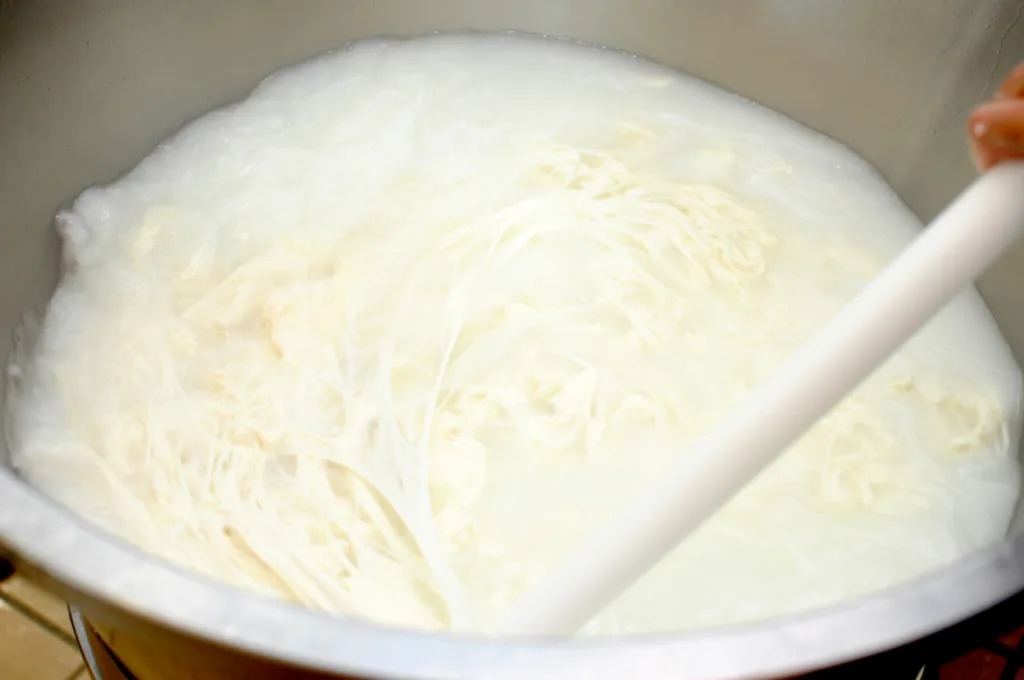If you’ve ever bought buttermilk for one recipe and then wondered what to do with the rest, you’re not alone. It’s one of those ingredients that’s amazing in small amounts but hard to use up unless you’ve got a plan. You might think it’s just for pancakes or biscuits, but honestly, it’s way more versatile than it gets credit for. Whether you’ve got a few tablespoons or a whole carton sitting in your fridge, this guide will help you figure out exactly how to put it to good use.
We’re diving into real recipes and smart ideas. From savory meals to sweet treats and everything in between, these are the kinds of dishes you’ll actually want to make, and eat.
If you’re trying to figure out what to make with buttermilk, having a place to save and sort all the good ideas really helps. That’s where ReciMe comes in. With our app, you can collect recipes from anywhere – Instagram, TikTok, your favorite blogs, and keep them in one spot. It’s a lot easier to plan meals or use up ingredients when your saved recipes aren’t scattered across screenshots and tabs. And if you’ve got a few go-to buttermilk recipes, you can tag them, drop them into a weekly meal plan, or build your grocery list around them in just a few taps.

Download for free from the App Store on iPhone and iPad

ReciMe Android App

Why Buttermilk Deserves a Spot in Your Fridge
Before we jump into the recipes, let’s talk about what makes buttermilk so useful. First off, it’s not just about flavor (although that tang is pretty great). It’s also a multitasker:
- Adds tenderness to baked goods thanks to its acidity
- Helps create crispy coatings on fried foods
- Works as a marinade that breaks down proteins without making meat mushy
- Makes salad dressings creamier without needing extra mayo or cream
It’s also lower in fat than you’d expect, and a little goes a long way.
Buttermilk in Global Cuisines
Buttermilk might be a Southern kitchen staple in the U.S., but it has deep roots in cooking traditions around the world. In Indian households, for example, buttermilk is more than just an ingredient – it’s part of daily life. It’s used in drinks like chaas, a refreshing, salted yogurt-buttermilk blend often served with spices after meals. It’s also the base for kadhi, a comforting stew made with chickpea flour and sometimes packed with dumplings or greens. It’s tangy, light, and soothing all at once.
In Scandinavian cooking, buttermilk shows up in everything from cold soups to rustic rye breads. You’ll also find it in Eastern European kitchens, where it’s blended into soups or used as a tenderizer in meat marinades. In Middle Eastern cooking, buttermilk or yogurt drinks serve a similar role, cooling the palate and adding balance to bold spices. Even in Korea, buttermilk’s close cousin, cultured milk, is used in modern recipes to tenderize proteins and enrich sauces. So while you might think of it as something to bake with or throw into pancakes, buttermilk is quietly doing important work in kitchens all over the world.
Baking with Buttermilk (Beyond the Usual Suspects)
Let’s start with the obvious: baking. But let’s not stop at pancakes.

1. Buttermilk Scones and Biscuits
Buttermilk is the secret to light, tender scones and biscuits with just the right amount of tang. For scones, start by sifting together flour, baking powder, sugar, and salt. Cut cold butter into the dry ingredients until the mixture resembles coarse crumbs. Gently mix in buttermilk until the dough comes together, but don’t overwork it. Shape into a disc, cut into wedges, and bake at 425°F for about 15 minutes. For biscuits, combine flour, baking powder, and a pinch of salt, then cut in cold butter until pea-sized. Stir in the buttermilk until just combined, and drop spoonfuls onto a baking sheet. Bake for 10-12 minutes until golden.
For a twist, try adding grated lemon zest or fresh herbs like rosemary to your scones. If you’re making biscuits, you can even mix in sharp cheddar for an extra savory bite.
2. Banana Bread and Muffins
Buttermilk helps banana bread stay incredibly moist while adding a slight tang that cuts through the sweetness. Start by creaming butter and sugar in a bowl before adding eggs and mashed bananas. Mix in buttermilk and vanilla extract, then fold in your dry ingredients – flour, baking soda, and a pinch of salt. For muffins, simply reduce the baking time to around 18-20 minutes at 375°F, and don’t forget to add chocolate chips or chopped nuts if you want extra texture. You can also try swapping the butter for brown butter for a nutty richness and adding a splash of bourbon for a deeper flavor profile.
3. Buttermilk Pancakes, Waffles, and English Muffins
When it comes to pancakes, buttermilk is a game-changer for extra fluff. For a classic pancake batter, whisk together flour, baking soda, salt, and sugar. In a separate bowl, combine buttermilk, eggs, and melted butter, then pour the wet ingredients into the dry and stir until just combined. Don’t overmix, the batter should be lumpy! Cook on a hot griddle or skillet for about 2-3 minutes per side, until golden brown.
For waffles, mix the same ingredients but add an extra tablespoon of sugar to get that crispy, golden exterior. If you’re up for a challenge, try making English muffins by mixing buttermilk with flour, yeast, sugar, and salt. Let the dough rise, then portion it into rounds and cook on a hot griddle for about 6-7 minutes on each side. They’ll be soft inside with those signature craggy nooks perfect for jam or butter.
4. Cakes and Cobblers
Buttermilk gives cakes a soft crumb and a slight tang that balances out the sweetness. For a Texas Sheet Cake, mix together cocoa, flour, sugar, and buttermilk, then add baking soda and eggs. Pour into a sheet pan, bake at 350°F for 30 minutes, and top with a warm chocolate icing made from butter, milk, and powdered sugar. It’s simple but indulgent.
For cobblers, combine a fruit of your choice – peaches, berries, or apples – with sugar, lemon juice, and cornstarch. For the topping, mix flour, baking powder, sugar, salt, and a pinch of cinnamon. Stir in buttermilk, then spoon the batter over the fruit. Bake at 375°F for about 35 minutes until bubbly and golden. You’ll have a dessert that’s warm, comforting, and the perfect mix of sweet fruit and tangy biscuit topping.
Savory Dishes That Love Buttermilk
You don’t need to bake to use buttermilk. In fact, some of the best uses are savory.

5. Buttermilk Fried Chicken (and Friends)
The secret to the juiciest fried chicken? Buttermilk. Soak bone-in, skin-on chicken pieces in buttermilk, garlic, and a pinch of hot sauce for at least 4 hours (overnight is best). When you’re ready, coat the chicken in seasoned flour, then fry until crispy and golden brown. The buttermilk tenderizes the chicken while helping the crispy coating stick. For a twist, try a piri piri version by adding lemon, garlic, and chili peppers to the buttermilk marinade before frying. You can also bake it for a lighter version that’s just as tasty.
6. Pork, Broccoli, and More
Buttermilk isn’t just for chicken. It works wonders as a marinade for pork tenderloin or ribs. For tender, flavorful pork, marinate the meat in buttermilk, garlic, and a squeeze of lemon for about 2-3 hours. The buttermilk’s acidity helps break down the meat while adding a subtle tang that enhances the natural flavors. You can also use buttermilk to roast vegetables, like broccoli, for a quick side dish. Toss the broccoli with buttermilk, garlic, and a sprinkle of Parmesan before roasting at 400°F for about 20 minutes.
7. Buttermilk Beans and Dumplings
If you haven’t tried buttermilk in beans, now’s the time. It makes a rich, creamy base for stews. For a hearty dish, marinate white beans in buttermilk and garlic, then simmer them with olive oil, onions, and herbs. Serve the beans with soft dumplings made from flour, butter, and buttermilk. This is comfort food at its finest, especially on a cold day.
Dressings, Sauces, and Salads
Even a few tablespoons of buttermilk can totally change a dish.
8. Homemade Ranch
Store-bought ranch dressing can be convenient, but making it at home with buttermilk gives you a fresher, more flavorful version. Start with equal parts buttermilk and mayonnaise as the base. To this, add finely minced garlic, a teaspoon of Dijon mustard, and a dash of paprika to bring some warmth and depth to the flavor. Stir in a handful of fresh herbs – dill, chives, and parsley work best, but feel free to experiment with what you have. Season generously with salt and pepper to taste. This homemade ranch dressing is smooth, creamy, and tangy, perfect for dipping veggies, pouring over a fresh salad, or even drizzling on a baked potato. You can adjust the thickness by adding more buttermilk if you prefer a thinner consistency. The best part? You know exactly what’s in it, and it only takes a few minutes to whip up.

9. Blue Cheese and Bagna Cauda
If you love blue cheese dressing, you’ll appreciate this homemade version with buttermilk. Begin by whisking together buttermilk and crumbled blue cheese. To add creaminess, fold in a little sour cream or Greek yogurt, which will also help mellow the tanginess. Add a splash of lemon juice for a bit of brightness, then finish with freshly cracked black pepper. The result is a creamy, zesty blue cheese dressing that’s perfect for dipping crisp veggies, drizzling over a wedge salad, or pairing with buffalo wings.
Alternatively, for a different buttermilk dip, try bagna cauda, a traditional Italian warm dip. Heat olive oil and garlic in a pan, then stir in a few anchovies until they melt into the oil. Once the garlic softens, add buttermilk to create a smooth, creamy consistency. This dip, with its rich and savory flavors, pairs beautifully with raw vegetables like carrots and celery, grilled meats, or even roasted potatoes. It’s simple, bold, and absolutely delicious.
10. Buttermilk in Salads
Buttermilk is an excellent addition to creamy salad dressings. When you want a dressing that’s creamy but not too heavy, use buttermilk as the base. For a simple vinaigrette, whisk together buttermilk, olive oil, and a splash of lemon juice, then season with salt, pepper, and a pinch of mustard for extra tang. This light, zesty dressing is great for leafy greens, or you can drizzle it over roasted vegetables to add a bit of creaminess without being overwhelming.
Buttermilk also adds depth to classic coleslaw or potato salad. It’s perfect for making a dressing that’s lighter than mayonnaise but still rich enough to coat the ingredients. Try it in a Napa cabbage salad with thinly sliced apples, Parmesan cheese, and a sprinkling of toasted nuts. The buttermilk will provide just the right amount of acidity to cut through the creaminess of the cheese and the crunch of the cabbage, making each bite refreshing and satisfying.
Breakfast and Brunch Upgrades
Start your day with buttermilk, and you might not go back to your usual routine.
11. Overnight Pancakes and Oatmeal Bakes
If you love pancakes but don’t have time in the morning, try incorporating buttermilk into your overnight pancake batter. Mix the dry ingredients (flour, baking powder, sugar, salt) in one bowl, and the wet ingredients (buttermilk, eggs, vanilla extract, melted butter) in another. Combine the two and leave it in the fridge overnight. In the morning, you’ll have thick, fluffy pancakes without the hassle of mixing batter when you’re half-awake. If you prefer oatmeal for breakfast, buttermilk is a great addition to overnight oatmeal bakes as well. Stir it into the oats, along with some brown sugar, cinnamon, and raisins. Bake it the next morning for a creamy, tangy breakfast that’s also a great make-ahead option for busy days.

12. Buttermilk Eggs and Greens
Take your scrambled eggs or omelets to the next level by whisking in a tablespoon or two of buttermilk before cooking. This will give your eggs a silky, creamy texture that’s light but still indulgent. For an extra special twist, sauté some garlicky greens (spinach, kale, or chard) in olive oil and a pinch of salt until tender. Add in the buttermilk and cook the greens for a few more minutes until they’re coated in a velvety sauce. Pour over your scrambled eggs or serve alongside a poached egg for an elevated brunch dish. This simple combination feels luxurious without requiring a lot of effort, and the buttermilk’s mild tang cuts through the richness of the eggs and greens.
Unexpected Uses for Buttermilk
Still got some left? These ideas might surprise you.
13. Mashed Potatoes
Buttermilk can replace milk or cream in mashed potatoes to add a subtle tang and creaminess. For an extra depth of flavor, try using it in mashed sweet potatoes or mashed leeks, where the tangy buttermilk perfectly complements the natural sweetness of the vegetables. Just swap in buttermilk for about half of the liquid you’d normally use. The result is velvety potatoes that are lighter but still rich enough to hold their own against your main dish. It’s especially useful when serving buttery mains like roasted meats or fried chicken, where the tang helps cut through the richness of the meal.
14. Ice Cream, Sherbet, and Milkshakes
For a refreshing twist on frozen desserts, buttermilk is a great ingredient to blend into milkshakes, ice cream, and sherbet. The acidity adds a nice contrast to the sweetness of fruit, chocolate, or sugar. For a quick milkshake, blend roasted strawberries with vanilla ice cream, buttermilk, and a splash of honey. If you’re making sherbet, combine buttermilk with peaches or mangoes and freeze for a creamy, tangy dessert that’s easy to prepare and perfect for hot days. You don’t even need an ice cream machine for these – just blend, freeze, and enjoy.
15. Pies and Custards
Buttermilk is a secret weapon in many old-school pies, especially custard-based ones like chess pie or sweet potato pie. The acidity of the buttermilk balances the sugar and helps prevent the filling from becoming overly sweet. It adds richness without the heaviness of cream, creating a smooth, velvety custard texture. Add fresh berries on top of your pie or fold them into the custard for a pop of color and flavor. The result is a perfectly balanced pie that’s indulgent but not overwhelming.
When You Only Have a Little Left
Still hanging onto that last bit? These quick, no-recipe ideas make it easy to use up every drop.

16. Scrambled Eggs or Omelets
Add a splash of buttermilk to your eggs before cooking, and you’ll get a softer, creamier texture without needing to load them up with butter or cream. For scrambled eggs, whisk the eggs and buttermilk together until smooth, then cook over medium-low heat, stirring gently until they set. The buttermilk will keep them creamy and light. For omelets, follow the same process, but pour the mixture into a hot, oiled skillet, allowing it to set on the bottom before gently lifting the edges to let the uncooked mixture flow to the edges. This simple upgrade turns a basic breakfast into something extra special, with minimal effort.
17. Soup or Stew Finisher
Buttermilk is a fantastic way to finish off soups and stews, adding a rich, creamy texture without the heaviness of cream. Stir in a spoonful of buttermilk just before serving to add a tangy balance to the richness of lentil soups, vegetable stews, or even a mild curry. The acidity of the buttermilk cuts through the hearty flavors and adds a smooth, velvety finish. Just be sure not to boil the soup after adding it, as high heat can cause the buttermilk to separate. This little trick works especially well in dishes like tomato soup or a creamy potato leek stew.
18. Bread or Pizza Dough
When making bread or pizza dough, swap out some of the liquid for buttermilk. It not only adds a slight tang but also helps create a softer, more tender crumb and a golden-brown crust. For pizza dough, simply replace part of the water or milk in your recipe with buttermilk. Knead the dough as usual, and let it rise. When baked, the crust will be a little more flavorful and just the right amount of crisp. You can do the same with bread, add a bit of buttermilk to the mix to give the loaf a light texture and a subtle depth of flavor. Perfect for rustic loaves, rolls, or even a quick pizza night.
19. Mashed Avocado
If you’ve run out of lime or yogurt for your mashed avocado, buttermilk can step in and provide the same creamy, tangy kick with a smooth consistency. Mash the avocado as you normally would, then stir in just a couple of tablespoons of buttermilk until you achieve your desired texture. The buttermilk will thin out the avocado just enough for a dip or spread, and it balances the richness with its slight acidity. This makes for an excellent avocado toast topping or a side dish with tacos or grilled meats.
20. Quick Salad Dressing
In need of a fast, light dressing to bring a salad to life? Whisk together buttermilk, olive oil, lemon juice, and a pinch of salt for a simple, fresh dressing. Add a dash of mustard or freshly chopped herbs if you’re feeling fancy, but the base ingredients are enough to bring out the flavors of any salad. This dressing is especially great on leafy greens, roasted veggies, or even as a drizzle on a simple cucumber and tomato salad. It’s a quick way to freshen up leftovers or turn a last-minute salad into something with just the right balance of tang and creaminess.
21. Cold Pasta or Potato Salads
When you’re dealing with cold pasta or potato salads and want something easy, buttermilk is the perfect addition. Simply toss your cooked pasta or boiled potatoes with a little buttermilk, mayo, and vinegar to create a creamy dressing. You don’t need to follow a strict recipe here, just mix the ingredients until you get the right balance of tang and creaminess. Adjust the amount of buttermilk to your taste, and feel free to add extras like mustard, fresh herbs, or a pinch of paprika to liven things up. It’s a great way to use up that leftover buttermilk, especially when you’re working with odds and ends in your fridge.

How to Store and Freeze Buttermilk
Buttermilk doesn’t always come in small, convenient containers. Sometimes you only need half a cup for a recipe, and the rest just sits there, waiting for a plan that never happens. The good news is, you don’t have to rush to use it within a couple of days. Buttermilk actually lasts longer than people think, especially if you store it properly. Just keep it sealed tight in the coldest part of your fridge, not the door. If it smells tangy but not sour in a bad way, it’s likely still good. A little separation is normal, just shake it before using.
If you know you won’t get around to using it anytime soon, freezing is your backup move. You can pour it into small containers or even an ice cube tray and freeze individual portions for later. Once frozen, pop them into a zip-top bag and stash them in the freezer. They won’t thaw out perfectly smooth, but that’s fine for baking, marinades, or dressings. When you’re ready to use it, let it thaw in the fridge overnight or give it a gentle stir if it separates. It might not be Instagram-pretty, but it’ll work just fine in recipes.
Conclusion
Buttermilk might seem like a one-recipe ingredient, but once you see what it can actually do, it earns its spot in your fridge. It’s the kind of thing that quietly improves everything from pancakes to fried chicken to a spoonful of mashed potatoes. The best part is, you don’t need to overthink it. A few tablespoons here and there can stretch your ingredients, balance out flavors, or just make something feel a little more put together. Whether you’re baking, marinating, blending, or tossing it into a dressing, buttermilk doesn’t need to be complicated to be useful. And with ReciMe, it’s easier than ever to keep track of what you’ve already tried and what’s worth making again.
FAQ
What’s the best way to use up leftover buttermilk if I don’t feel like baking?
You’ve got options. It works great as a marinade for chicken or pork, adds richness to soups, and can make a quick salad dressing or sauce. Even a few spoonfuls in scrambled eggs or mashed potatoes makes a difference.
Can I freeze buttermilk?
Yes, and it’s surprisingly easy. Pour it into small containers or freeze it in cubes, then thaw what you need later. It won’t look exactly the same when it thaws, but it works just fine in most recipes.
Does buttermilk go bad quickly?
Not as quickly as you’d think. It lasts longer than regular milk when stored properly. A little separation is normal. Just give it a shake and a sniff. If it smells tangy but not off, it’s probably still good.
Is there a way to make buttermilk if I don’t have any?
You can make a simple version at home by mixing a tablespoon of lemon juice or vinegar into a cup of milk. Let it sit for about 5 to 10 minutes and use it like you would store-bought buttermilk.
Do sweet and savory recipes use the same kind of buttermilk?
They do. Most store-bought buttermilk is cultured and works across the board. It brings acidity to baked goods and tenderness to proteins, so it fits into both sweet and savory dishes without needing a separate version.
What’s the deal with powdered buttermilk? Can I use that instead?
Powdered buttermilk is a shelf-stable backup that’s handy if you don’t use the fresh stuff often. You mix it with water based on the directions and it does the job in most recipes, especially baking. It’s not great for dressings or marinades where flavor and texture matter more, but it gets the job done in a pinch.
